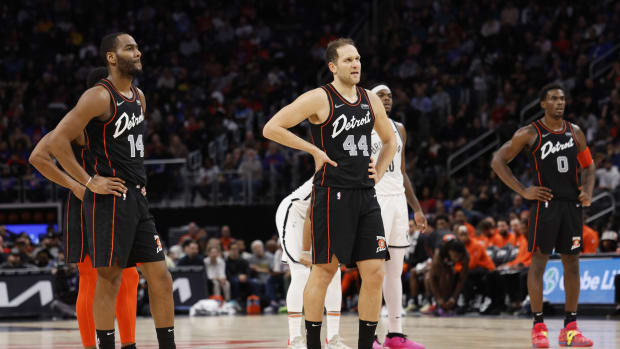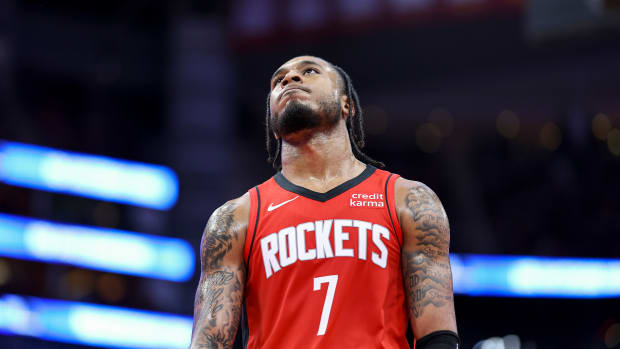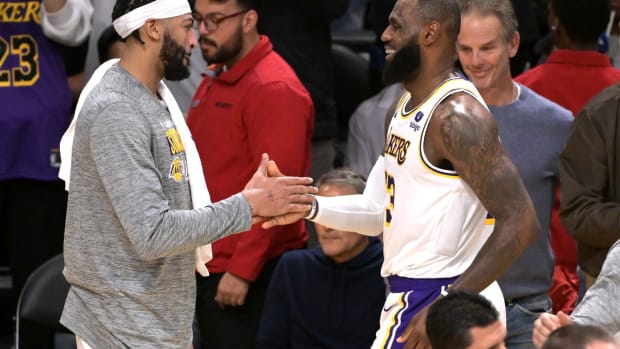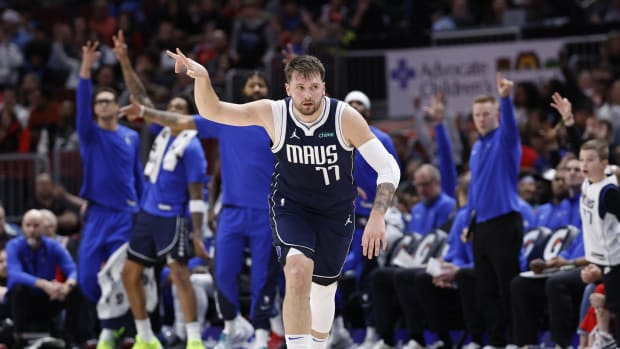How Blake Griffin Remade His Body and Returned to All-Star Form
Just past 10:30 a.m., Blake Griffin is ready for us. Trevor Harrison, the star forward’s personal therapist and trainer, and I have been waiting in the lobby of one of the glossy five-star hotels NBA teams frequent in New York City. The Pistons arrived in midtown Manhattan as late Monday night turned into early Tuesday morning, after Detroit shellacked Denver 129-103 at home, boarded a chartered plane and jetted east. So on the second day of a back-to-back, we’ve been summoned to the All-Star’s room to readjust the hulking body that’s ever important to the Pistons’ delicate playoff hopes.
Griffin’s 6’10” frame nearly fills the entire doorway as he welcomes us into the suite’s living room. His handshake engulfs mine. NBA TV plays in the background, rolling through the previous evening’s highlights, including Detroit’s upset over the upstart Nuggets. “Season low 23 minutes,” Griffin tells us, proudly. Amidst a campaign averaging 36.2 ticks per outing—the highest mark since his second season—the eight-year veteran sat the entire fourth quarter against Denver. For one of the bounciest big men in NBA history, four weeks shy of his—in sports parlance, dreaded—30th birthday, Griffin’s career has become as much about finely tuning that chiseled instrument as digesting film of opponents’ pick-and-roll coverages. “Over the years, I’ve tried to really learn a lot about my body,” Griffin says. He studied health and exercise science during his two years at Oklahoma.
Big Interview: Kemba Walker on His Special Bond With Charlotte
As Harrison unfolds a cushioned treatment table, Griffin wheels a cart of now-devoured, room service breakfast out into the hallway, spilling leftover milk in the process. The duo first met in January 2017, in between devastating injuries that derailed Griffin’s, and subsequently the Clippers’, 2016 and 2017 postseason runs, the latter effectively ending Lob City all together. They determined the right big toe injury that eliminated Griffin two years ago was nothing short of a freak accident, when he somehow injured a patellar plate storming into the paint for a routine layup against the Jazz. That entire summer limited Griffin to upper body strength training and pliability table work. Each of Griffin’s scars from surgeries past signify time lost. “My growth in my game was stunted,” he says. “That’s not my style. I don’t work like that.”
And while the seismic trade that delivered Griffin to Detroit didn’t birth the playoff appearance the Pistons hoped, 2018 provided his first fully-healthy summer since… longer than he can remember while Harrison prods his ankles with a Hypervolt massage gun. “It was huge just because I was able to build,” Griffin says. “I always felt like the last two, three summers I was struggling trying to get healthy, trying to get to a place where I could start training camp. The first time I was able to get on the court was mid-August, and I was limited to 20 minutes of just spot-shooting, no movement or anything like that.” Griffin has since averaged a career-high 26.2 points per game en route to his sixth All-Star selection and first since 2014-15. He is faster and stronger, soaring and shooting more efficiently than ever before. “I have peace of mind of knowing when I get on the court, there’s nothing that’s bothering me or restricting me from getting the most out of that movement.” He has reemerged on the league’s marquee, shining alongside the game’s biggest names. That his return coincides with the healthiest stretch of his career has been nothing close to coincidence.
Before his fingers traversed the muscles of star athletes, Harrison played professional rugby in both the U.S. and Canada. His father and brother went pro in hockey, his mother a fabled equestrian rider and sister a national champion in her own right. “All of us retired at 26, 27 because of non-contact injuries,” he says. The Harrisons were all trained on Vancouver Island to be bigger, faster and stronger, snowballing muscle and ignoring the biomechanics required to best utilize such ferocious strength. Harrison’s own plight unlocked a different world of athletics, pushing him toward acquiring a massage therapy and personal training license. He began working with offensive lineman on the Pittsburgh Steelers and Arizona Cardinals, even babysitting clients’ children when they took their wives on date nights.
He came under the mentorship of longtime Phoenix Suns trainer Mike Clark, and spent two years learning his specialized system, combining integrated manual therapy: table work predicated on muscle groups and limbs’ range of motion; corrective exercise: designed to teach body parts how to function within an optimal range of motion; strengthening or stabilization, and then recovery. A tight muscle will always cause a weakness in its opposite muscle. If an athlete undergoes manual therapy and doesn’t exercise, their muscles immediately tense back up. If athletes solely strength train, the opposite muscles tighten in that process. Clark’s magic loosens what’s tight, strengthens what’s weak, and then maintains a prime range of motion for peak performance. “Systematically, that’s how the body works,” Harrison says.
SHARP: The New Normal for DeMarcus Cousins and the Warriors
The first athlete Clark ever referred to Harrison was then-Suns center Shaquille O’Neal, Phoenix’s behemoth. He received an opening voicemail from the self-proclaimed Big Shaqtus while driving. “I almost swerved off the road,” Harrison says. Clark connected Harrison with Grant Hill, Shawn Marion and Amare Stoudemire. He began working with Kobe Bryant. Eventually Harrison broke off on his own, launching Athlete Health First. Harrison now has eight full-time trainers on staff, three based in London to work with high-profile celebrity clients in entertainment. Fellow Eastern Conference All-Star Kemba Walker is also on Harrison’s roster, as is Nuggets forward Paul Millsap and a slew of G-League players. They have partnerships established with the Jazz, Timberwolves and Pittsburgh University’s basketball team. Most of Harrison’s business develops through word of mouth, as Griffin connected AHF with his old college coach Jeff Capel’s Panthers. The one thing he lacks in today’s modern landscape is a website and social media presence. “I’m like that old guy that doesn’t know how to do it,” Harrison laughs.
I first met Harrison in mid August, when Walker plopped onto a training table at the National Basketball Players Association after an afternoon workout with Hornets assistant coach Jay Hernandez. He began kneading the shifty point guard’s muscle tissue with a Hypervolt identical to the routine he utilized in Griffin’s hotel room months later. No matter the athlete or the trainer within his company, they practice the same treatment to within, what Harrison estimates, 95% of the same touch. “It’s an algorithm,” he says. “It’s reproducible.”
As proof, Harrison’s associate Corey Bickert invited me to a midtown performance center just a few blocks south of Madison Square Garden for my own musculoskeletal consultation. Bickert evaluated my body’s form during multiple squatting positions on both two legs and one, various shoulder movements, as well as my trunk/lumbar spine pliability. I then slid onto a training table, just like Walker and Griffin would begin a routine session. Bickert yanked and contorted each of my limbs, both lying face down and while on my back, taking each, precise measurement with a goniometer. It’s a plastic device with two rectangular arms protruding from a circle, allowing its user to mark any degree physically possible.
Every human’s big toes, from Griffin’s to yours, need to bend between 40-70 degrees, for example. If not, then you lose a certain amount of power. If your toe is not bending, your foot turns out. As soon as your foot turns out, you use the outside calf more than both sides of the calf muscle. Then your knee rotates inward, which obviously puts stress on the entire knee joint. Knowing a person’s ideal degree of motion for each body part serves two functions. It allows Harrison and his crew to pinpoint exactly where a client’s lingering issue originates, and it also assists in stretching muscle groups back to their range of motion for optimal performance. After roughly 20 minutes of Bickert digging into muscle and tissue, my overall body movement increased from 55.88% to 83.60%. “It’s more effective,” Griffin later says. “I’ve never had a trainer where you start on the table and you get off, you feel better. Always. Every time.”
Back inside the lavish hotel quarters, Harrison digs both his thumbs into Griffin’s lower back, instructing the big man to lift his torso like an upward-facing-dog yoga position. Griffin is wearing a blue Pistons hoodie, grey Jordan sweat shorts and two full-length compression sleeves on each leg to enhance his recovery from the night before. He credits Detroit’s training staff for welcoming an outside practitioner like Harrison, while some organizations would scoff at foreign hands. The relationship between Tom Brady’s guru Alex Guerrero and the New England Patriots has infamously been far from symbiotic. Detroit conversely invites Harrison onto the team plane, inside its pregame locker room and the team’s medical staff will even sometimes ask him to work on other players.
“If I didn’t trust him, I wouldn’t have him around as much as I do,” Griffin says. He lifts his head up from the orange pillow separating his skull from the table. “He probably knows more about my body then he should,” the All-Star quips. Harrison has celebrated Easter with Griffin’s family. His son has swam in the Griffin’s backyard pool with the superstar’s own children. “He’s been around for a lot,” Griffin says. Either Harrison or his associate Erik Phillips will meet with Griffin roughly 21 days each month. They gameplan sessions two months in advance, mapping where the Pistons schedule overlaps with Harrison’s and Phillips’. It’s all diagrammed in a google calendar each member of the AHF team has access to.
This stretch, for example, Phillips worked on Griffin prior to the the Nuggets game, and then flew back to his home base in Denver. Harrison met Griffin at the hotel this morning. He and Griffin will again collaborate on a training table before tonight’s Knicks game, and afterwards, Harrison will join the Pistons traveling party, fly back to Detroit and see Griffin on the table Wednesday morning. Thursday Griffin’s body will be untouched. “You can’t keep beating up muscle,” Harrison says. “At some point, you need some time off.”
SHAPIRO: Winners and Losers From NBA All-Star Draft
“So many trainers are gimmicky,” Griffin says. “I’ve been around a lot of trainers and strength coaches and they’ll get a new toy. They’ll use the new toy for two months and it’s gone and you never see it again. Everything I’ve done from the first time I worked with him, we still do today.” Once he leaves Harrison and I at 11:30 a.m., Griffin will meet the Pistons’ medical staff on the 15th floor and use a blood restriction device that can hyperdirect his blood flow to specific areas of his body, another element of stimulating his recovery. He’ll sit through Detroit’s team meeting, return to his room, eat lunch, slip into a personal pair of NormaTec recovery boots, nap, and then see Harrison again before his pregame lift and pregame shooting. “We all have our routines,” Griffin says. “We’re all creatures of habit.”
Reciting his joints’ specific measurements has become ingrained in that daily minutiae. Griffin and Harrison have collaborated long enough, he can feel and anticipate when a certain area won’t reach its maximum range of motion. “I know they were good today,” Griffin boasts. “Had to be. You can just tell. Ankles, internal rotation, external rotation, hips, all that.” He knows hips move in three functions and that a human ankle should be able to rotate between zero and 20 degrees. You need 12 degrees of rotation just to stand and running requires 12 to 20 degrees. When Griffin first lies on the table, Harrison will log a first measurement on the goniometer before they begin tissue work. “My ankles used to be at seven and six,” Griffin says, as if answering a memorized fact for an exam. “I don’t know that I’ve been below nine, maybe.”
His body is in better condition entering the All-Star break than ever before. “Everyone right now is probably playing at 80%, healthwise,” Griffin says. “I feel like I’m probably closer to 100 than I am 80. Right now I feel like the strongest, like when I do a single-leg balance, when I’m doing something, I can feel everything working the way it should be working.” This summer, he was able to hone on endurance strength more so than trying to maintain or recharge to a certain level of activity. Griffin’s strength work with Harrison instead was able to build up endurance for the 82-game season. Monday through Friday they would begin workouts on the table, enter the weight room for a rigorous lift, and then flow straight onto the court where Griffin collaborated with Noah LaRoche. “In order to do the skill work, I need be be able to maximize every movement.”
FISCHER: Press Conferences Can Be Awkward for Role Players
With LaRoche, Griffin could finally simulate game situations at full speed, rather than spot shooting amidst rehabbing a nagging lower body injury. They’d mimic the Pistons’ schemes with as many as nine coaches, drilling different pick-and-roll reads and opposing defensive progressions. An additional foe always stood at the rim, ready to bat any of Griffins layup or dunk attempts with a big stick. Finishing through contact has grown far less of an arduous task.
“When I’m off balance,” Griffin slides off the table back in his hotel room, miming a drive across the paint with a euro-step. “You know, when you’re coming through the lane, planting on one leg, getting hit, the ability to take contact I think has been big doing all of our single-leg work, single-leg step ups.” Deceleration has been a major component of their training as well. Ever since the original knee injury that curtailed his rookie year, being able to explode yet land after that explosion and be ready for impact has become a focal point of Griffin’s strength work. He has never utilized this full arsenal of primed muscle and athleticism more than this season. Griffin has played and started in 53 of Detroit’s 55 games. Both absences came only while resting on the second night of a back-to-back. He is drilling 36.2% of his threes on a career-best 6.8 attempts per night.
“Over the years, coming back from injury after injury and just trying to be healthy to play, and now feeling a difference," Griffin said, "not just being healthy, but feeling more prepared and conditioned for the season is a big thing. That’s where I really feel a difference, in back-to-backs and stuff like that.” There is a second half of a back-to-back to be played tonight, after all. Griffin and Harrison slap hands as we all depart his hotel room. He will hang 29 points, six rebounds, eight assists in 38 minutes during the Pistons’ 105-92 win against the Knicks. “And next year is gonna be even better,” Harrison promises.




































